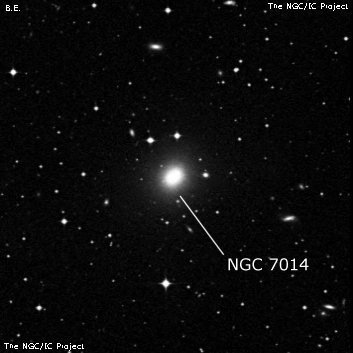
ESO 286-049, situated 11' W, is the second brightest cluster member or equal in visibility to NGC 7014. It was noted as fairly bright, fairly small, very small and very bright core, halo elongated 3:2 N-S, 0.6'x0.4'. A mag 10.8 star lies 2.5' NE. The general field is fairly well populated with stars.
LEDA 506328 is 3.7' N and appeared faint to fairly faint, very small, slightly elongated ~E-W, 18"x12".
LEDA 101199 is 8' ENE and noted as faint, small, elongated 3:2 NNW-SSE, low surface brightness. A mag 16 star is situated at the NNW tip.
LEDA 130607, located just 1.5' SW of ESO 286-049 and 12' SW of NGC 7014, appeared very faint, very small, round, 10" diameter.
John Herschel discovered NGC 7014 = h3852 on 2 Oct 1834 and recorded "pF; S; R: bM; has 2 st 12th mag north." His position is at the south edge of ESO 286-057 = PGC 66153 and the two stars are 1.2' north of center.
600/800mm - 30" (10/10/15 - OzSky): this galaxy is the brightest member of AGC 3742 = ACO S924 = Indus Group (part of the Pavo-Indus Supercluster). At 394x it appeared fairly bright, moderately large, sharply concentrated with an intense core, slightly elongated halo ~1.2'x1.0'. Two mag 13.5 stars oriented E-W are 1.2' N.
Notes by Steve Gottlieb